
Illustrative Math Alignment: Grade 8 Unit 3
Linear Equations and Linear Systems
Lesson 5: Solving Any Linear Equation
Use the following Media4Math resources with this Illustrative Math lesson.
| Thumbnail Image | Title | Body | Curriculum Topic |
|---|---|---|---|

|
Closed Captioned Video: Anatomy of an Equation: Quadratic Equations 3 | Closed Captioned Video: Anatomy of an Equation: Quadratic Equations 3
In this video, analyze the steps in solving a quadratic equation with two roots. In this video we work with this version of the quadratic equation: ax^2 - bx + c = 0. . . |
Quadratic Equations and Functions |
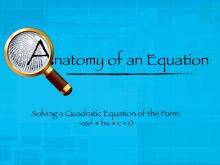
|
Closed Captioned Video: Anatomy of an Equation: Quadratic Equations 4 | Closed Captioned Video: Anatomy of an Equation: Quadratic Equations 4
In this video, analyze the steps in solving a quadratic equation with two roots. In this video we work with this version of the quadratic equation: -ax^2 + bx + c = 0. . . |
Quadratic Equations and Functions |
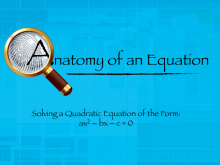
|
Closed Captioned Video: Anatomy of an Equation: Quadratic Equations 5 | Closed Captioned Video: Anatomy of an Equation: Quadratic Equations 5
In this video, analyze the steps in solving a quadratic equation with two roots. In this video we work with this version of the quadratic equation: ax^2 - bx - c = 0. . . |
Quadratic Equations and Functions |
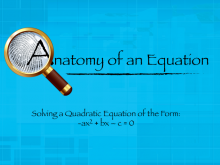
|
Closed Captioned Video: Anatomy of an Equation: Quadratic Equations 6 | Closed Captioned Video: Anatomy of an Equation: Quadratic Equations 6
In this video, analyze the steps in solving a quadratic equation with two roots. In this video we work with this version of the quadratic equation: -ax^2 + bx - c = 0. . . |
Quadratic Equations and Functions |
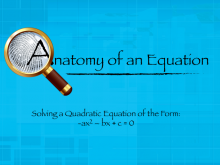
|
Closed Captioned Video: Anatomy of an Equation: Quadratic Equations 7 | Closed Captioned Video: Anatomy of an Equation: Quadratic Equations 7
In this video, analyze the steps in solving a quadratic equation with two roots. In this video we work with this version of the quadratic equation: -ax^2 - bx + c = 0. . . |
Quadratic Equations and Functions |
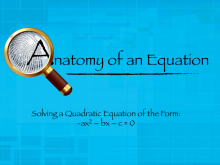
|
Closed Captioned Video: Anatomy of an Equation: Quadratic Equations 8 | Closed Captioned Video: Anatomy of an Equation: Quadratic Equations 8
In this video, analyze the steps in solving a quadratic equation with two roots. In this video we work with this version of the quadratic equation: -ax^2 - bx - c = 0. . . |
Quadratic Equations and Functions |
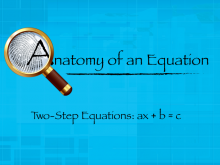
|
Closed Captioned Video: Anatomy of an Equation: Two-Step Equations 1 | Closed Captioned Video: Anatomy of an Equation: Two-Step Equations 1
In this video learn the mechanics of solving a two-step equation involving addition and multiplication. . |
Solving Two-Step Equations |

|
Closed Captioned Video: Anatomy of an Equation: Two-Step Equations 10 | Closed Captioned Video: Anatomy of an Equation: Two-Step Equations 10
In this video learn the mechanics of solving a two-step equation involving addition and division. In this variation, the x-term has a negative coefficient. . |
Solving Two-Step Equations |

|
Closed Captioned Video: Anatomy of an Equation: Two-Step Equations 11 | Closed Captioned Video: Anatomy of an Equation: Two-Step Equations 11
In this video learn the mechanics of solving a two-step equation involving addition and division. In this variation, the x-term has a negative coefficient. In this variation, the term on the other side of the equals sign is negative. . |
Solving Two-Step Equations |
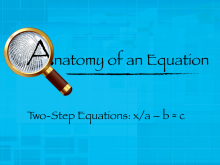
|
Closed Captioned Video: Anatomy of an Equation: Two-Step Equations 12 | Closed Captioned Video: Anatomy of an Equation: Two-Step Equations 12
In this video learn the mechanics of solving a two-step equation involving subtraction and division. . |
Solving Two-Step Equations |
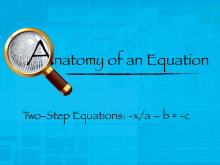
|
Closed Captioned Video: Anatomy of an Equation: Two-Step Equations 13 | Closed Captioned Video: Anatomy of an Equation: Two-Step Equations 13
In this video learn the mechanics of solving a two-step equation involving subtraction and division. In this variation, the x-term has a negative coefficient. In this variation, the term on the other side of the equals sign is negative. . |
Solving Two-Step Equations |
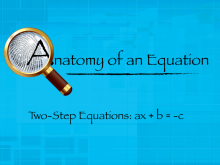
|
Closed Captioned Video: Anatomy of an Equation: Two-Step Equations 2 | Closed Captioned Video: Anatomy of an Equation: Two-Step Equations 2
In this video learn the mechanics of solving a two-step equation involving addition and multiplication. In this variation, the term on the other side of the equals sign is negative. . |
Solving Two-Step Equations |
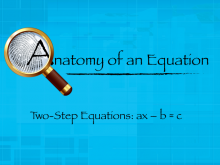
|
Closed Captioned Video: Anatomy of an Equation: Two-Step Equations 3 | Closed Captioned Video: Anatomy of an Equation: Two-Step Equations 3
In this video learn the mechanics of solving a two-step equation involving subtraction and multiplication. . |
Solving Two-Step Equations |
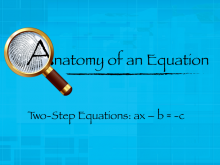
|
Closed Captioned Video: Anatomy of an Equation: Two-Step Equations 4 | Closed Captioned Video: Anatomy of an Equation: Two-Step Equations 4
In this video learn the mechanics of solving a two-step equation involving subtraction and multiplication. In this variation, the number on the other side of the equals sign is negative. . |
Solving Two-Step Equations |
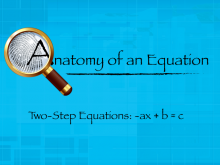
|
Closed Captioned Video: Anatomy of an Equation: Two-Step Equations 5 | Closed Captioned Video: Anatomy of an Equation: Two-Step Equations 5
In this video learn the mechanics of solving a two-step equation involving addition and multiplication. In this variation, the x-term has a negative coefficient. . |
Solving Two-Step Equations |
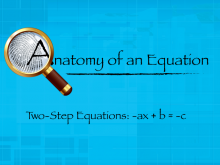
|
Closed Captioned Video: Anatomy of an Equation: Two-Step Equations 6 | Closed Captioned Video: Anatomy of an Equation: Two-Step Equations 6
In this video learn the mechanics of solving a two-step equation involving addition and multiplication. In this variation, the x-term has a negative coefficient and the term on the other side of the equals sign is negative. . |
Solving Two-Step Equations |
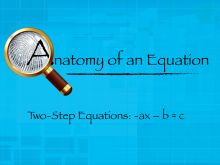
|
Closed Captioned Video: Anatomy of an Equation: Two-Step Equations 7 | Closed Captioned Video: Anatomy of an Equation: Two-Step Equations 7
In this video learn the mechanics of solving a two-step equation involving subtraction and multiplication. In this variation, the x-term has a negative coefficient. . |
Solving Two-Step Equations |
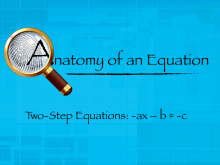
|
Closed Captioned Video: Anatomy of an Equation: Two-Step Equations 8 | Closed Captioned Video: Anatomy of an Equation: Two-Step Equations 8
In this video learn the mechanics of solving a two-step equation involving subtraction and multiplication. In this variation, the x-term has a negative coefficient and the term on the other side of the equals sign is negative. . |
Solving Two-Step Equations |

|
Closed Captioned Video: Anatomy of an Equation: Two-Step Equations 9 | Closed Captioned Video: Anatomy of an Equation: Two-Step Equations 9
In this video learn the mechanics of solving a two-step equation involving addition and division. . |
Solving Two-Step Equations |

|
Closed Captioned Video: One-Step Equations: Addition | Closed Captioned Video: One-Step Equations: Addition
Video Tutorial: One-Step Equations: Addition. In this video, get an overview of one-step equations and how to solve them. In particular, look at one-step addition equations. |
Solving One-Step Equations |

|
Closed Captioned Video: One-Step Equations: Division | Closed Captioned Video: One-Step Equations: Division
Video Tutorial: One-Step Equations: Division. In this video, students get an overview of one-step equations and how to solve them. In particular, look at one-step division equations. |
Solving One-Step Equations |

|
Closed Captioned Video: One-Step Equations: Multiplication | Closed Captioned Video: One-Step Equations: Multiplication
Video Tutorial: One-Step Equations: Multiplication. In this video, students get an overview of one-step equations and how to solve them. In particular, look at one-step multiplication equations. |
Solving One-Step Equations |
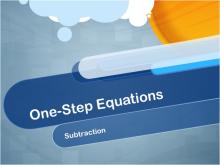
|
Closed Captioned Video: One-Step Equations: Subtraction | Closed Captioned Video: One-Step Equations: Subtraction
Video Tutorial: One-Step Equations: Subtraction. In this video, students get an overview of one-step equations and how to solve them. In particular, look at one-step subtraction equations. |
Solving One-Step Equations |

|
Closed Captioned Video: Overview of Variables and Equations | Closed Captioned Video: Overview of Variables and Equations
In this video segment, get an overview of variables and equations, along with the evolution of algebraic notation. |
Applications of Equations and Inequalities, Variables and Unknowns and Variable Expressions |

|
Closed Captioned Video: Two-Step Equations: Division and Addition | Closed Captioned Video: Two-Step Equations: Division and Addition
Video Tutorial: Two-Step Equations: Division and Addition. In this video, we will solve a two-step equation that involves division and addition. |
Solving Two-Step Equations |
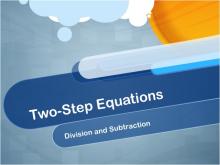
|
Closed Captioned Video: Two-Step Equations: Division and Subtraction | Closed Captioned Video: Two-Step Equations: Division and Subtraction
Video Tutorial: Two-Step Equations: Division and Subtraction. In this video, we will solve a two-step equation that involves division and subtraction. |
Solving Two-Step Equations |

|
Closed Captioned Video: Two-Step Equations: Multiplication and Addition | Closed Captioned Video: Two-Step Equations: Multiplication and Addition
Video Tutorial: Two-Step Equations: Multiplication and Addition. In this video, we will solve a two-step equation that involves multiplication and addition. |
Solving Two-Step Equations |
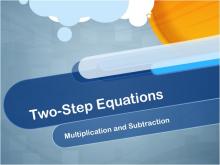
|
Closed Captioned Video: Two-Step Equations: Multiplication and Subtraction | Closed Captioned Video: Two-Step Equations: Multiplication and Subtraction
Video Tutorial: Two-Step Equations: Multiplication and Subtraction. In this video, we will solve a two-step equation that involves multiplication and subtraction. |
Solving Two-Step Equations |
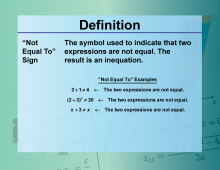
|
Definition--Equation Concepts--"Not Equal To" | Not Equal ToTopicEquations DefinitionThe "Not Equal To" symbol (≠) is used to indicate that two values are not equal. DescriptionThe "Not Equal To" symbol is crucial in mathematics as it denotes inequality between two expressions. This symbol is used in various mathematical contexts, such as solving inequalities, comparing numbers, and expressing conditions in algebraic equations. For example, in the inequality 𝑥 ≠ 5, it means that x can be any number except 5. |
Numerical and Algebraic Expressions |
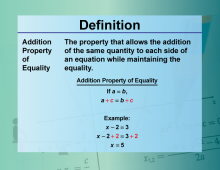
|
Definition--Equation Concepts--Addition Property of Equality | Addition Property of EqualityTopicEquations DefinitionThe Addition Property of Equality states that if you add the same value to both sides of an equation, the equality remains true. DescriptionThe Addition Property of Equality is a fundamental principle in algebra. It asserts that for any real numbers a, b, and c, if a = b, then a + c = b + c. This property is used to solve equations and maintain balance. For example, to solve x − 3 = 7, you add 3 to both sides to get x = 10. |
Applications of Equations and Inequalities |
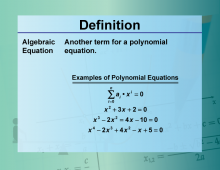
|
Definition--Equation Concepts--Algebraic Equation | Algebraic EquationTopicEquations DefinitionAn algebraic equation is a mathematical statement that shows the equality of two algebraic expressions. It's also another way of referring to a polynomial equation. DescriptionAlgebraic equations are central to algebra and involve variables, constants, and arithmetic operations. They are used to represent relationships and solve problems. For instance, the equation 2x + 3 = 7 can be solved to find x. Algebraic equations come in various forms, including linear, quadratic, and polynomial equations. |
Applications of Equations and Inequalities |
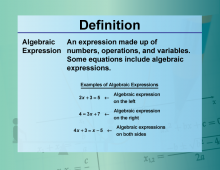
|
Definition--Equation Concepts--Algebraic Expression | Algebraic ExpressionTopicEquations DefinitionAn algebraic expression is a combination of variables, constants, and arithmetic operations, without an equality sign. DescriptionAlgebraic expressions are fundamental components of algebra. They represent quantities and relationships without asserting equality. Examples include 3x + 4 and 5y − 2. Unlike equations, expressions cannot be solved but can be simplified or evaluated for given variable values. |
Numerical and Algebraic Expressions |
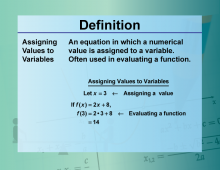
|
Definition--Equation Concepts--Assigning Values to Variables | Assigning Values to VariablesTopicEquations DefinitionAssigning values to variables involves giving specific values to variables in an equation or expression. DescriptionAssigning values to variables is a fundamental process in algebra. It involves substituting variables with specific numbers to evaluate expressions or solve equations. For example, in the equation y = 2x + 3 assigning x = 4 gives y = 11. |
Variable Expressions |
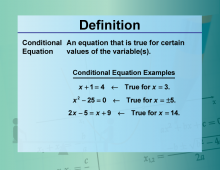
|
Definition--Equation Concepts--Conditional Equation | Conditional EquationTopicEquations DefinitionA conditional equation is true only for specific values of the variable(s). DescriptionConditional equations are equations that hold true only under certain conditions or for specific variable values. For example, the equation x2 = 4 is true only when x = 2 or x = −2. These equations contrast with identities, which are true for all variable values. |
Applications of Equations and Inequalities |
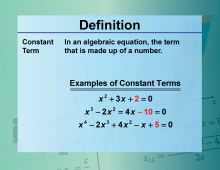
|
Definition--Equation Concepts--Constant Term | Constant TermTopicEquations DefinitionA constant term is a term in an algebraic expression that does not contain any variables. DescriptionConstant terms are fixed values in algebraic expressions and equations. They do not change because they lack variables. For example, in the expression 3x + 4 the number 4 is a constant term. Constant terms are essential in forming and solving equations. |
Variables and Unknowns |
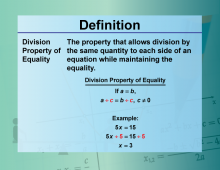
|
Definition--Equation Concepts--Division Property of Equality | Division Property of EqualityTopicEquations DefinitionThe Division Property of Equality states that if you divide both sides of an equation by the same nonzero value, the equality remains true. DescriptionThe Division Property of Equality is a key principle in algebra. It states that for any real numbers a, b, and c (where 𝑐 ≠ 0), if a = b, then a ÷ c = b ÷ c This property is used to solve equations by isolating variables. For example, to solve 3x = 12 divide both sides by 3 to get x = 4. |
Applications of Equations and Inequalities |

|
Definition--Equation Concepts--Equality | EqualityTopicEquations DefinitionEquality is a mathematical statement that asserts that two expressions are equal. DescriptionEquality is a foundational concept in mathematics. It indicates that two expressions have the same value, represented by the symbol "=". For example, in the equation 2 + 3 = 5, both sides are equal. Equality is used to form equations and solve problems. In real-world applications, equality is used in accounting, engineering, and data analysis to ensure balance and accuracy. Understanding equality helps students develop logical reasoning and problem-solving skills. |
Applications of Equations and Inequalities |
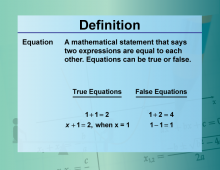
|
Definition--Equation Concepts--Equation | EquationTopicEquations DefinitionAn equation is a mathematical statement that asserts the equality of two expressions. DescriptionEquations are central to mathematics, representing relationships between quantities. They consist of two expressions separated by an equals sign. For example, 2x + 3 = 7 is an equation that can be solved to find x. Equations can be linear, quadratic, or polynomial, among others. |
Applications of Equations and Inequalities |
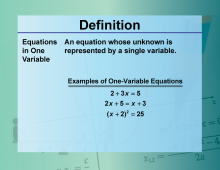
|
Definition--Equation Concepts--Equations in One Variable | Equations in One VariableTopicEquations DefinitionEquations in one variable involve a single variable and can be solved to find its value. DescriptionEquations in one variable are fundamental in algebra. They typically take the form of ax + b = 0, where x is the variable. Solving these equations involves isolating the variable to determine its value. For example, solving 2x + 3 = 7 yields x = 2 |
Applications of Equations and Inequalities |

|
Definition--Equation Concepts--Equations in Two Variables | Equations in Two VariablesTopicEquations DefinitionEquations in two variables involve two variables and describe a relationship between them. DescriptionEquations in two variables are essential in algebra and coordinate geometry. They typically take the form of ax + by = c and represent lines in a coordinate plane. For example, the equation 2x + 3y = 6 can be graphed as a line. |
Applications of Equations and Inequalities |
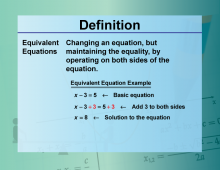
|
Definition--Equation Concepts--Equivalent Equations | Equivalent EquationsTopicEquations DefinitionEquivalent equations are equations that have the same solutions. DescriptionEquivalent equations are a key concept in algebra. They may look different but yield the same solutions. For instance, 2x + 3 = 7 and 4x + 6 = 14 are equivalent because both have the solution x = 2. Transformations such as addition, subtraction, multiplication, or division can produce equivalent equations. |
Applications of Equations and Inequalities |
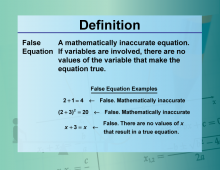
|
Definition--Equation Concepts--False Equation | False EquationTopicEquations DefinitionA false equation is an equation that is not true for any value of the variable(s). DescriptionFalse equations are equations that do not hold true for any value of the variable(s). For example, the equation x + 2 = x + 3 is false because there is no value of x that makes both sides equal. Identifying false equations is important in verifying the validity of mathematical statements. |
Applications of Equations and Inequalities |
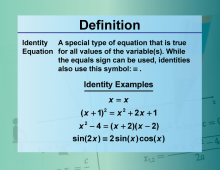
|
Definition--Equation Concepts--Identity Equation | Identity EquationTopicEquations DefinitionAn identity equation is true for all values of the variable(s). DescriptionIdentity equations are equations that hold true for all values of the variable(s). For example, the equation 2(x + 1) = 2x + 2 is an identity because it is true for any value of x. These equations are used to express mathematical identities and properties. In the equation above, the identity results from the use of the distributive property. |
Applications of Equations and Inequalities |
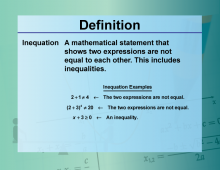
|
Definition--Equation Concepts--Inequation | InequationTopicEquations DefinitionAn inequation is a mathematical statement that shows the inequality between two expressions. DescriptionInequations, or inequalities, are statements that compare two expressions using inequality symbols such as >, <, ≥, and ≤. For example, x + 3 > 5 indicates that 𝑥 x must be greater than 2. Inequations are used to represent constraints and conditions in mathematical models. Inequations sometimes involve the inequality symbol: ≠. |
Inequalities |
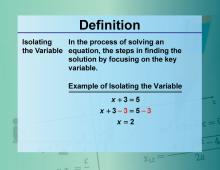
|
Definition--Equation Concepts--Isolating the Variable | Isolating the VariableTopicEquations DefinitionIsolating the variable involves manipulating an equation to get the variable alone on one side. DescriptionIsolating the variable is a fundamental technique in algebra used to solve equations. It involves performing operations to both sides of an equation to get the variable by itself. For example, solving 2x + 3 = 7 involves subtracting 3 and then dividing by 2 to isolate x, resulting in x = 2. |
Variables and Unknowns |
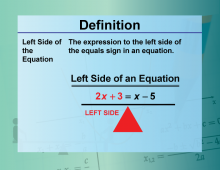
|
Definition--Equation Concepts--Left Side of the Equation | Left Side of the EquationTopicEquations DefinitionThe left side of the equation refers to the expression on the left side of the equals sign. DescriptionThe left side of an equation is the part of the equation that appears before the equals sign. For example, in the equation 2x + 3 = 7 the left side is 2x + 3. Understanding the left side of the equation is crucial for solving and balancing equations. In real-world applications, recognizing the left side of an equation helps in setting up and solving problems accurately. It is essential for students to understand this concept to manipulate and solve equations effectively. |
Applications of Equations and Inequalities |
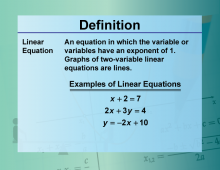
|
Definition--Equation Concepts--Linear Equation | Linear EquationTopicEquations DefinitionA linear equation is an equation that does not have an variables raised to a power higher than one. A linear equation can have one or more variables. DescriptionLinear equations are fundamental in algebra and describe relationships are summarized below. |
Applications of Linear Functions |
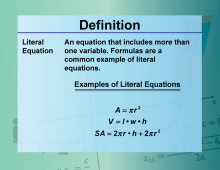
|
Definition--Equation Concepts--Literal Equation | Literal EquationTopicEquations DefinitionA literal equation is an equation that involves two or more variables. DescriptionLiteral equations involve multiple variables and are used to express relationships between them. For example, the formula for the area of a rectangle, A = l•w is a literal equation involving the variables l and w. Solving literal equations often involves isolating one variable in terms of the others. |
Applications of Equations and Inequalities |
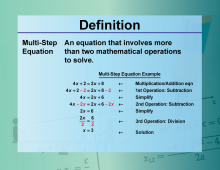
|
Definition--Equation Concepts--Multi-Step Equation | Multi-Step EquationTopicEquations DefinitionA multi-step equation requires more than one step to solve. DescriptionMulti-step equations involve multiple operations to isolate the variable. For example, solving 3x + 2 = 11 requires subtracting 2 and then dividing by 3 to find x=3. These equations are common in algebra and require a systematic approach to solve. In real-world applications, multi-step equations are used in complex problem-solving scenarios such as engineering and finance. Understanding how to solve multi-step equations helps students develop critical thinking and problem-solving skills. |
Solving Multistep Equations |
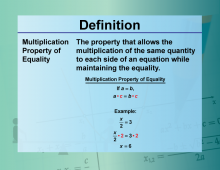
|
Definition--Equation Concepts--Multiplication Property of Equality | Multiplication Property of EqualityTopicEquations DefinitionThe Multiplication Property of Equality states that if you multiply both sides of an equation by the same nonzero value, the equality remains true. DescriptionThe Multiplication Property of Equality is a fundamental principle in algebra. It states that for any real numbers a, b, and c (where 𝑐 ≠ 0), if a = b, then ac = bc This property is used to solve equations by isolating variables. For example, to solve x/3 = 4 you multiply both sides by 3 to get x = 12. |
Applications of Equations and Inequalities |